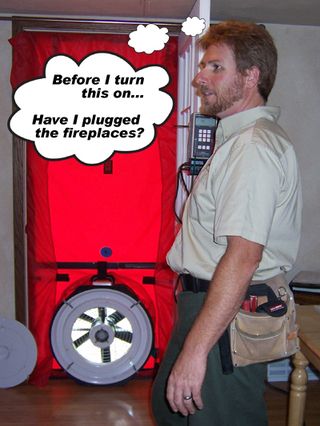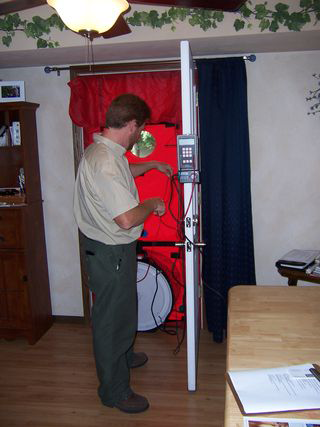
Blower Door Testing and the Fireplace Chimney “Soot Puff”
Blower Door Testing
I love going to tradeshows because it is a time that service professionals like Energy Raters and Chimney Sweeps can give us feedback on the applications that they use the Chimney Balloon in. At the 2009 ACI Conference in Kansas City, some energy auditors told us about how they use the Chimney Balloon to solve a very common fireplace soot issue during blower door testing.
Every rookie energy rater makes this mistake at least once. You go to a home to do an energy audit and just go straight to setting up the blower door kit. You look around the house and close up all the exterior doors and windows but completely neglect to look at the fireplaces. You fire up the blower door and suddenly notice a gathering grey soot cloud billowing from the living room. You know what you did wrong, you forgot to seal the fireplace. But it is too late…you already sucked a bunch of soot down the chimney and into the home. This makes the homeowner pretty ticked off and is not a good first impression.
Sometimes this even happens if you have the fireplace damper closed. Chimneys are filled with dust, and loose soot and metal dampers are notoriously leaky, so when you bring a house down to -50 pascal you can suck an enormous amount of air through the chimney and that will draw the loose soot and dust down too. It is like taking a drinking straw that has dust lined on the inside of it and briskly inhaling through it. *cough*cough*
The old school method is to take a wet towel and toss it over the ashes in the firebox, but that doesn’t do anything for the soot that comes down the chimney. Or you can take plastic and tape it around the hearth to try to seal it that way but bricks are difficult to seal against and the tape can leave a residue. Also, this takes time to cut and tape off the plastic.
The easiest thing to do is keep a couple of the common sized Chimney Balloons handy (like a 9×9, 12×12, 24×12 and 36×15) and a Chimney Balloon pump handy and quickly inflate a Chimney Balloon in the fireplace before you start the blower door. This solution is quick and easy, and it seals nice and tight so you don’t take any chances.
The energy raters I spoke with offer Chimney Balloons to their customers as an additional product in their energy rating. So when they put the Chimney Balloon in, they bring the homeowner over to show them what they are doing and explain how sealing off the flue is a benefit not only for the blower door test but also for saving energy long term as well. 99% of the time the homeowner then asks the rater to just leave the Chimney Balloon in place and bill them for it. After all, it is probably one of the least expensive and simple improvements the homeowner can make that will significantly improve the blower door test results.
